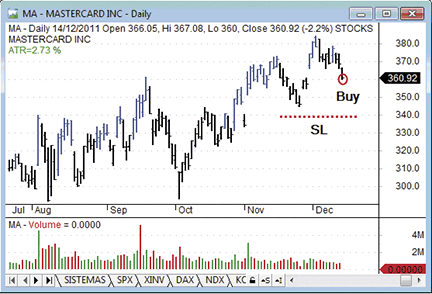
FIGURE 1: MONEY MANAGEMENT STRATEGY APPLIED TO MASTERCARD (MA). The price is $360 and stop-loss is placed below the previous low at $340. Risk is $20 per share.
MONEY MANAGEMENT
Unfixing The Fixed Rate
Here’s a modification to the fixed rate strategy that makes it not so fixed. This variation looks at four levels of risk and uses the one most appropriate to current market characteristics.
One of the simplest and more efficient money management strategies is the fixed risk concept, when you choose a percentage of available capital on the next trade. It is a very effective strategy in that it is based on increasing the amount of money risked in the next trade when you have more capital, thanks to the profits of previous trades. It also works well on the downside, risking less when you have less. This is referred to as an antimartingale strategy.
Here’s an antimartingale that works with a faster response. It is similar to an optimal ƒ strategy that looks at a few previous trades and updates the risk for the coming trades. I define four levels of risk and use the most appropriate for the current market situation.
The margin limitation
Most money management strategies stem from the world of financial derivatives. Strategies that work in futures or other derivatives don’t have to work in stocks because of the margin limitation. The biggest leverage usually available to trade stocks overnight is 2:1. That means that you will not be able to risk the optimal amount of money, since you are limited by the stock price.
Suppose you want to trade MasterCard (MA) after a pullback, with an entry price of $360 on December 14, 2011 (see Figure 1). The stop-loss is placed below the previous low ($340). The risk is $20 per share. Assume that you have $10,000 of trading capital and the optimal risk that your trading system indicates is 0.30, or 30%. Thus, you should risk $3,000, which means you buy 3,000/20 = 150 shares of MA.

FIGURE 1: MONEY MANAGEMENT STRATEGY APPLIED TO MASTERCARD (MA). The price is $360 and stop-loss is placed below the previous low at $340. Risk is $20 per share.
But 150 shares of MasterCard at the current price of $360 requires an investment of $54,000, which is far more than the $10,000 you have available. So it is impossible to risk 30% of your capital. Based on available capital, the maximum number of shares you can buy is 27. If you trade the maximum, then the risk is 27 x 20 = $540, or 5.4% of your capital. This is why optimal ƒ strategies are difficult to implement when trading stocks because of the margin limitations.
In general, you will not be able to risk more than 20% of your trading capital, depending on the price of the stock. Because of this I will establish 20% as the maximum risk.